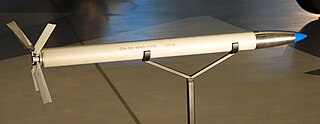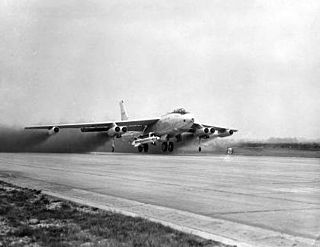
Air-to-ground weaponry is aircraft ordnance used by combat aircraft to attack ground targets. The weapons include bombs, machine guns, autocannons, air-to-surface missiles, rockets, air-launched cruise missiles and grenade launchers.

Air-to-ground weaponry is aircraft ordnance used by combat aircraft to attack ground targets. The weapons include bombs, machine guns, autocannons, air-to-surface missiles, rockets, air-launched cruise missiles and grenade launchers.

Fighter aircraft are fixed-wing military aircraft designed primarily for air-to-air combat. In military conflict, the role of fighter aircraft is to establish air superiority of the battlespace. Domination of the airspace above a battlefield permits bombers and attack aircraft to engage in tactical and strategic bombing of enemy targets.

In military terminology, a missile is a guided airborne ranged weapon capable of self-propelled flight usually by a jet engine or rocket motor. Missiles are thus also called guided missiles or guided rockets. Missiles have five system components: targeting, guidance system, flight system, engine and warhead. Missiles come in types adapted for different purposes: surface-to-surface and air-to-surface missiles, surface-to-air missiles, air-to-air missiles, and anti-satellite weapons.

A military aircraft is any fixed-wing or rotary-wing aircraft that is operated by a legal or insurrectionary military of any type. Military aircraft can be either combat or non-combat:

Anti-aircraft warfare, counter-air or air defence forces is the battlespace response to aerial warfare, defined by NATO as "all measures designed to nullify or reduce the effectiveness of hostile air action". It includes surface based, subsurface, and air-based weapon systems, associated sensor systems, command and control arrangements, and passive measures. It may be used to protect naval, ground, and air forces in any location. However, for most countries, the main effort has tended to be homeland defence. NATO refers to airborne air defence as counter-air and naval air defence as anti-aircraft warfare. Missile defence is an extension of air defence, as are initiatives to adapt air defence to the task of intercepting any projectile in flight.

The Henschel Hs 293 was a World War II German radio-guided glide bomb. It is the first operational anti-shipping missile, first used unsuccessfully on 25 August 1943 and then with increasing success over the next year, ultimately damaging or sinking at least 25 ships. Allied efforts to jam the radio control link were increasingly successful despite German efforts to counter them. The weapon remained in use through 1944 when it was also used as an air-to-ground weapon to attack bridges to prevent the Allied breakout after D-Day, but proved almost useless in this role.

An airstrike, air strike, or air raid is an offensive operation carried out by aircraft. Air strikes are delivered from aircraft such as blimps, balloons, fighter aircraft, attack aircraft, bombers, attack helicopters, and drones. The official definition includes all sorts of targets, including enemy air targets, but in popular usage the term is usually narrowed to a tactical (small-scale) attack on a ground or naval objective as opposed to a larger, more general attack such as carpet bombing. Weapons used in an airstrike can range from direct-fire aircraft-mounted cannons and machine guns, rockets and air-to-surface missiles, to various types of aerial bombs, glide bombs, cruise missiles, ballistic missiles, and even directed-energy weapons such as laser weapons.

RIM-7 Sea Sparrow is a U.S. ship-borne short-range anti-aircraft and anti-missile weapon system, primarily intended for defense against anti-ship missiles. The system was developed in the early 1960s from the AIM-7 Sparrow air-to-air missile as a lightweight "point-defense" weapon that could be retrofitted to existing ships as quickly as possible, often in place of existing gun-based anti-aircraft weapons. In this incarnation, it was a very simple system guided by a manually aimed radar illuminator.

Brimstone is a ground or air-launched ground attack missile developed by MBDA UK for the UK's Royal Air Force. It was originally intended for "fire-and-forget" use against mass formations of enemy armour, using a millimetre wave (mmW) active radar homing seeker to ensure accuracy even against moving targets. Experience in Afghanistan led to the addition of laser guidance in the dual-mode Brimstone missile, allowing a "spotter" to pick out specific and the highest priority targets, particularly useful to minimise collateral damage when friendly forces or civilians were in the area. The tandem shaped-charge warhead is much more effective against modern tanks than older similar weapons such as the AGM-65G Maverick missile. Three Brimstones are carried on a launcher that occupies a single weapon station, allowing a single aircraft to carry many missiles.

The Mk 4 Folding-Fin Aerial Rocket (FFAR), also known as "Mighty Mouse", was an unguided rocket used by United States military aircraft. It was 2.75 inches (70 mm) in diameter. Designed as an air-to-air weapon for interceptor aircraft to shoot down enemy bombers, it primarily saw service as an air-to-surface weapon. The FFAR has been developed into the modern Hydra 70 series, which is still in service.

An air-to-surface missile (ASM) or air-to-ground missile (AGM) is a missile designed to be launched from military aircraft at targets on land or sea. There are also unpowered guided glide bombs not considered missiles. The two most common propulsion systems for air-to-surface missiles are rocket motors, usually with shorter range, and slower, longer-range jet engines. Some Soviet-designed air-to-surface missiles are powered by ramjets, giving them both long range and high speed.

The Martin Mace was a ground-launched cruise missile developed from the earlier Martin TM-61 Matador. It used a new self-contained navigation system that eliminated the need to get updates from ground-based radio stations, and thereby allowed it to fly further beyond the front lines. To take advantage of this longer practical range, Mace was larger than Matador and could travel a longer total distance.

A live fire exercise (LFX) is a military exercise in which live ammunition and ordnance is used, as opposed to blanks or dummies. The term can also be found in non-military usage.

Operation Southern Watch was an air-centric military operation conducted by the United States Department of Defense from Summer 1992 to Spring 2003.

Multiservice tactical brevity codes are codes used by various military forces. The codes' procedure words, a type of voice procedure, are designed to convey complex information with a few words.

Bharat Dynamics Limited (BDL) is one of India's manufacturers of ammunitions and missile systems. It was founded in 1970 in Hyderabad, Telangana, India. BDL was established to be a manufacturing base for guided weapon systems and begun with a pool of engineers drawn from Indian Ordnance Factories, DRDO and aerospace industries, It began by producing a first generation anti-tank guided missile - the French SS11B1. This product was a culmination of a licence agreement the Government of India entered into with Aerospatiale. BDL has three manufacturing units, located at Kanchanbagh, Hyderabad, Telangana; Bhanur, Medak district, Telangana and Visakhapatnam, Andhra Pradesh.

The Henschel Hs 298 was a 1940s German rocket-powered air-to-air missile designed by Professor Herbert Wagner of Henschel.

Weapons System 199 (WS-199) was a weapons development program conducted by the United States Air Force to research and develop new strategic weapons systems for Strategic Air Command. Two air-launched and one ground-launched vehicles were developed as part of the program. While none entered production, they assisted in the development of both the GAM-87 Skybolt air-launched ballistic missile and that of re-entry vehicles for ballistic missiles.

The AAM-N-5 Meteor was an early American air-to-air missile, developed by the Massachusetts Institute of Technology and Bell Aircraft for the United States Navy. Initially, both air-launched and ship-launched versions were considered. Versions designed for launch from carrier-based aircraft proceeded to the flight testing stage before the project was cancelled.

The United States Army's Nike Ajax was the world's first operational guided surface-to-air missile (SAM), entering service in 1954. Nike Ajax was designed to attack conventional bomber aircraft flying at high subsonic speeds and altitudes above 50,000 feet (15 km). Nike was initially deployed in the US to provide defense against Soviet bomber attacks, and was later deployed overseas to protect US bases, as well as being sold to various allied forces. Some examples remained in use until the 1970s.

On 21 November 1994, NATO aircraft taking part of Operation Deny Flight carried out an airstrike on the airbase of Udbina, Croatia, then part of the self-proclaimed Serbian Republic of Krajina. Krajina Serbs had been launching air attacks on neighbour Bosnia and Herzegovina from the base in support of allied Serbian forces there, specially during the battle of Bihac. NATO forces intervened in order to deter further attacks. Two anti-aircraft SA-2 missile sites that the Serbs had used to attack Bihac in the ground-to-ground mode and to engage NATO aircraft were also destroyed in the following days. The bombing of Udbina was the largest air combat operation in Europe since World War II, and the largest combat operation in NATO's history up to that time.